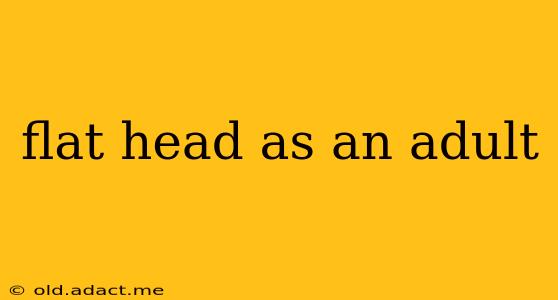A flat head, or positional plagiocephaly, is a condition characterized by an abnormally flattened area on the skull. While it's more commonly diagnosed in infants, it can also persist or develop into adulthood. This article will explore the causes, symptoms, and treatment options for flat head in adults, addressing common questions and concerns.
What Causes a Flat Head in Adults?
The causes of a flat head in adults differ from those in infants. While positional plagiocephaly (due to prolonged pressure on the skull) is the primary cause in babies, adult cases often stem from underlying conditions or past trauma.
- Positional Plagiocephaly (Persisting from Infancy): If a baby's plagiocephaly wasn't addressed in infancy, the flattening can persist into adulthood. This is less common if early interventions like repositioning and cranial remolding therapy were used.
- Craniosynostosis: This is a condition where the sutures (fibrous joints) in the skull fuse prematurely, restricting skull growth and leading to an irregular skull shape. This can manifest in adulthood if not diagnosed and treated in childhood.
- Trauma: Head injuries, such as those resulting from accidents or surgery, can cause skull deformities, including flattening.
- Underlying Medical Conditions: Certain medical conditions, like certain genetic disorders, can affect skull development and contribute to an irregular shape.
- Lambdoid Synostosis: Premature fusion of the lambdoid suture (located at the back of the skull) can cause flattening at the back and side of the head. This can occur during childhood, but the effects might not be fully apparent until adulthood.
Is a Flat Head in Adults Dangerous?
The danger associated with a flat head in an adult depends heavily on its cause. A flat head resulting from persistent positional plagiocephaly is usually purely cosmetic. However, a flat head stemming from craniosynostosis or significant trauma may indicate underlying health issues. Craniosynostosis, if untreated, can lead to increased intracranial pressure and neurological problems. Head trauma can have diverse consequences, depending on the severity. Therefore, it's crucial to consult a medical professional for a proper diagnosis and assessment.
Can a Flat Head in Adults Be Fixed?
Treatment options for a flat head in adults depend greatly on the underlying cause and the severity of the deformity.
- Cosmetic Procedures: For purely cosmetic concerns arising from positional plagiocephaly, surgical procedures such as cranioplasty may be considered. This involves reshaping the skull bone to improve its appearance.
- Craniosynostosis Surgery: If craniosynostosis is the cause, surgery may be necessary to separate the fused sutures, allowing for normal skull growth. The timing and specifics of the surgery depend on the individual case.
- Managing Underlying Conditions: If an underlying medical condition is contributing to the flat head, addressing that condition is crucial. This might involve medication, therapy, or other specialized treatments.
How is a Flat Head Diagnosed in Adults?
Diagnosis typically involves a thorough physical examination and review of the patient's medical history. Imaging techniques, such as X-rays, CT scans, and MRI scans, may be used to evaluate the skull's structure and identify any underlying issues. These scans help determine the cause of the flat head and rule out any serious medical conditions.
What are the Long-Term Effects of an Untreated Flat Head in Adults?
For a flat head resulting from positional plagiocephaly alone, there are typically no significant long-term health effects besides the cosmetic aspect. However, if a flat head is related to craniosynostosis or other underlying medical issues, leaving it untreated can have serious consequences. These consequences might include increased intracranial pressure, headaches, vision problems, and neurological deficits. Thus, timely diagnosis and treatment are vital.
Can a Helmet Help a Flat Head in Adults?
Helmets are primarily used in infants for correcting positional plagiocephaly. Their effectiveness in adults is very limited. Cranial remolding with helmets is typically not effective for adult plagiocephaly because the skull bones are more rigid and less malleable than in infants.
This information is for educational purposes only and should not be considered medical advice. Always consult with a healthcare professional for any concerns regarding your health. They can provide a proper diagnosis and recommend the appropriate treatment plan.
